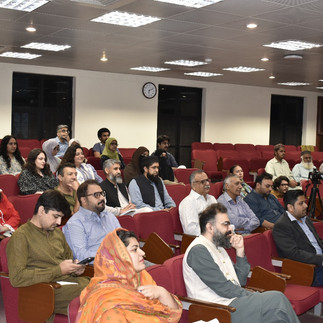Explore Lahore by Syed Faizan Abbas Naqvi
- asadullah3
- Nov 5
- 3 min read
Friday, 31 October, 2025 | 6:00 - 8:00 PM | A-11 Auditorium, Academic Block, LUMS

The Gurmani Centre for Languages and Literature hosted the launch of Explore Lahore: لاہور کی کھوج by Syed Faizan Abbas Naqvi, a detailed documentation of Lahore’s fading heritage. The session was chaired by Kamran Lashari and moderated by Ghazi Taimoor, who opened the evening with warmth and enthusiasm, introducing both speakers as individuals whose lives and work are intimately intertwined with the city of Lahore. The discussion unfolded as a celebration of Lahore, not merely as geography but as a living, breathing space of affiliation, memory, and identity.
In their remarks, the panel emphasized that the city functions as a site of intellectual and emotional attachment, a landscape that shapes the creative and moral imagination of its inhabitants. Drawing from spatial theory and urban poetics, the conversation foregrounded how cities like Lahore are not passive backdrops but active participants in human experience — shaping identities, affiliations, and even moral sensibilities. Lahore, in this sense, emerged as both subject and metaphor: a space of belonging, a city that contains within its decaying walls the traces of centuries of aesthetic and spiritual life.
Faizan Naqvi, known as The Lahori Explorer (Lahore ka Khoji), shared insights from over a decade of his work exploring and documenting the city’s historical and forgotten monuments. His talk reflected a rare blend of historical inquiry and affective devotion. Naqvi remarked that while historians have written about Lahore for centuries, many aspects of its history remain unexplored — particularly those hidden in the bylanes, mosques, shrines, gurdwaras, temples, and ruins that escape formal historiography. Through his visual and narrative documentation, he seeks to recover these overlooked fragments, preserving the city’s sensory and emotional histories before they vanish beneath the pressures of modernization.
One of the most compelling moments of the discussion came when Naqvi spoke about Buddhu’s Awa, a site he explores in detail in his book. He narrated the legend of Buddhu’s kiln — how its story blends moral parable, architecture, and myth — turning a decaying structure into a living text of Lahore’s moral and cultural imagination. The image of the broken furnace and the forgotten graveyard became, in his words, “a reminder of how cities remember through ruins.” This reflection beautifully illustrated how space, in Lahore’s case, becomes both archive and narrative, a palimpsest of overlapping eras, beliefs, and sensibilities.
In his response, Kamran Lashari reflected on the institutional efforts and personal commitments required to preserve Lahore’s heritage. Drawing on his tenure as Director General of the Walled City of Lahore Authority, he spoke candidly about the challenges of urban preservation amid bureaucratic inertia and commercial expansion. He also shared personal memories of his own home in Mazang, using them to evoke the intimate relationship between Lahoris and their city — a relationship characterized by affection, nostalgia, and resilience. Lashari’s reflections complemented Naqvi’s work, grounding the conversation in the lived continuity of Lahore as both civic and emotional space.
The session concluded with an engaging question-and-answer round that extended the discussion into reflections on collective memory, urban identity, and the politics of preservation. The dialogue, at its heart, celebrated Lahore as a site of cultural imagination, where the city’s ruins, monuments, and streets continue to challenge our sense of history, identity, and belonging.















